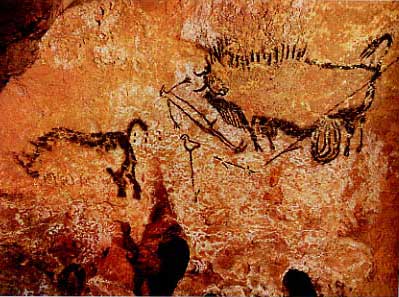
Therianthropes, Shamans, and Sorcerers
Among the approximately 100 painted caves of Europe, a handful have enigmatic paintings of human-animal composites, or "therianthropes," the meaning of which is and probably will remain a topic of speculation. In some cases we know that the paintings had a special significance for the people who created them because of their location. For example, the famous "hunting accident" in the Cave of Lascaux, pictured immediately below, is painted near the bottom of a twenty-foot shaft in a remote corner of the cave, with room enough only for a single person to view it at a time. The extreme rarity of the images and the fact that they depict human beings or human-like entities also suggest their unique importance. Scholars have interpreted the images variously as sorcerers, mythic ancestors, gods, and human hunters in costume. However, if we accept David-Lewis' interpretation of the geometric images on the walls of the Paleolithic caves, it is likely that therianthropic paintings depict shamans in states of trance. On this interpretation, the bird-headed human figure painted in the shaft at Lascaux is not the victim of a hunting accident, but a shaman whose ecstatic trance state is represented by an erect penis, hard to account for in other interpretations. The bird-headed staff, perhaps was a ritual instrument, and the bison spilling its entrails an animal spirit encountered and perhaps killed in the other world, in an act of hunting magic such as Abbe Breuil described.

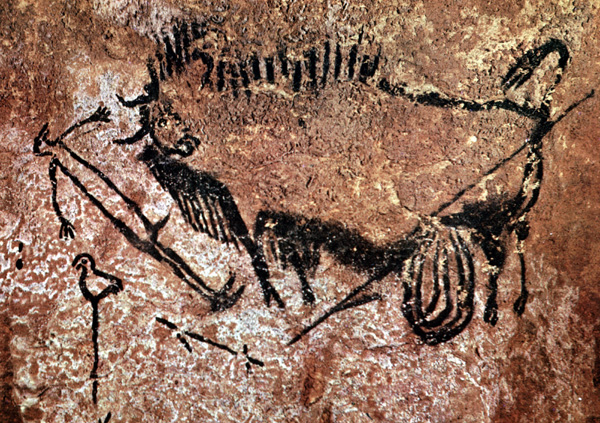
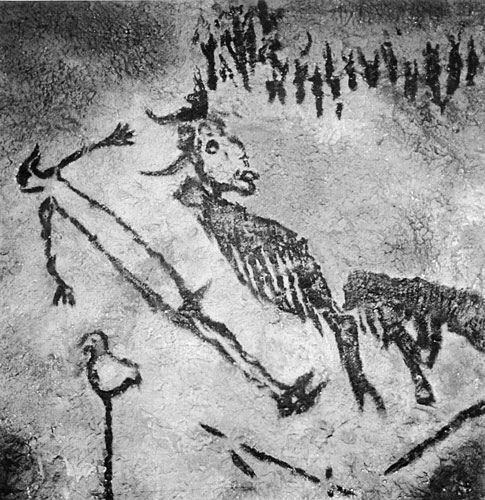
Compare the Lascaux painting with the following San Bushman image of a shaman reclining in the presence of eland antelopes.
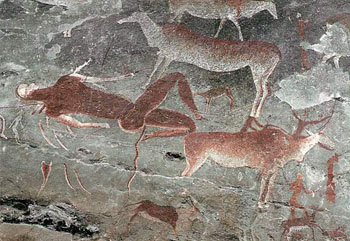
"No description of Lascaux is complete without the story of the Shaft. Just off the Apse, halfway along the passageway toward the Chamber of Felines, is a twenty-foot-deep hole, wide enough for one person to be in comfortably, but little more. A metal ladder is the way down, and a flashlight beam illuminates the scene. Among the sparkling yellow and white calcite crystals on the wall, a great black bison is poised for attack, its forelegs taut as a spring, its tail lashing. The animal appears to be desperately wounded, with what looks like a barbed spear across its body. Its entrails spill to the ground. A man has fallen in front of the bison, not a figure crafted with the fidelity of the other images in Lascaux, but a stickman with no life, wearing what might be a bird mask. Nearby, what looks like a bird on the end of a staff, perhaps a spear thrower, and a rhinoceros. All painted in black, and about as enigmatic as anything in Lascaux.
"The most obvious interpretation of the scene in the Shaft is that it is connected with hunting magic, perhaps the re-enactment of a hunting accident. But the most obvious explanation may not be the correct one, for three pairs of dots separate the rhinoceros from the rest of the scene. Simple in themselves, and perhaps without import, the dots are just one example of an element in Lascaux art, and in all cave art, that I have not yet mentioned. This is the profusion of nonrepresentational, geometric patterns. In addition to dots, there are grids and chevrons, curves and zigzags, and more. Many kinds of patterns are to be found, sometimes superimposed on animal images, sometimes separate from them. The coincidence of these geometric motifs with representational images is one of the most puzzling aspects of Upper Paleolithic art." - Richard Leaky, Origins Reconsidered
Abbe Breuil's tracing of "The Sorcerer" at the cave of Les Trois Freres
Once again note that the figure's sexual organ is prominent and erect.
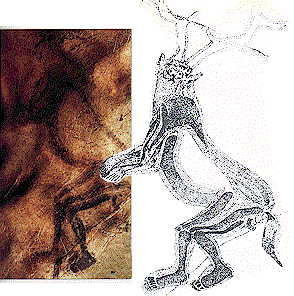
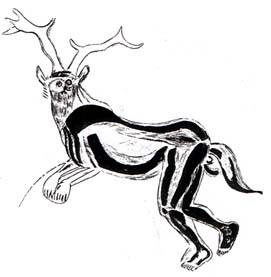
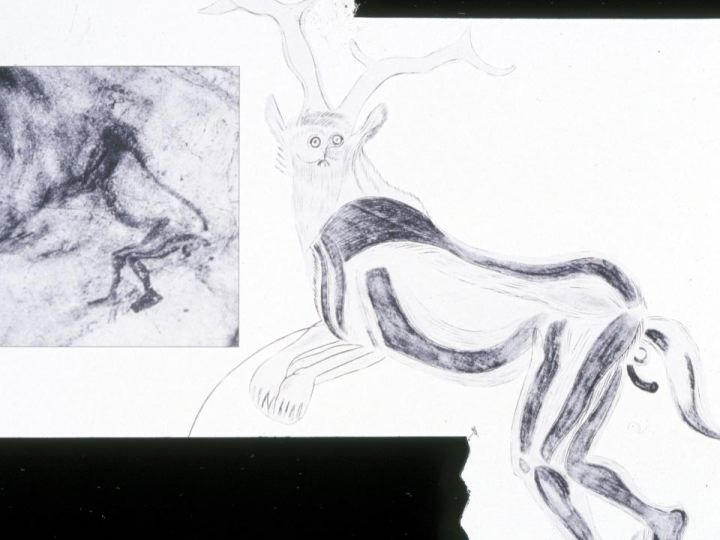
Bison-headed human figure from the cave of Gabillou (Dordogne, France)
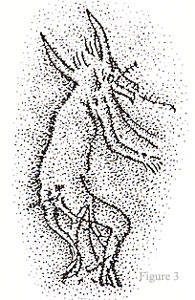
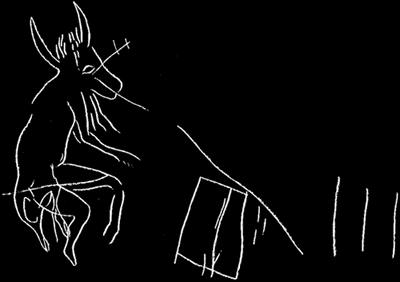
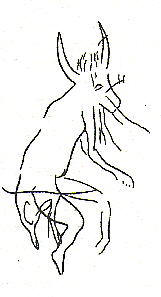
Another painting of a therianthrope from the cave of Les Trois Freres, this time in the midst of a throng of bison, horses, and rhinos
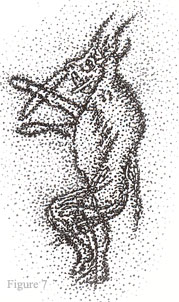
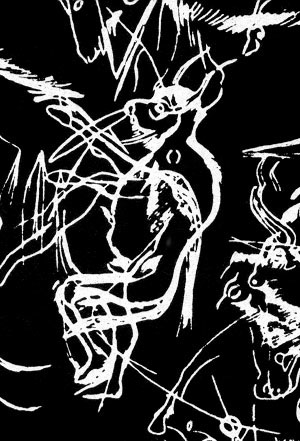
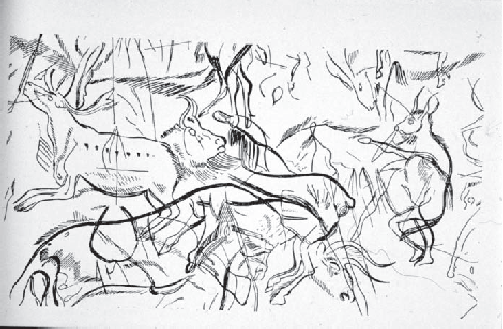

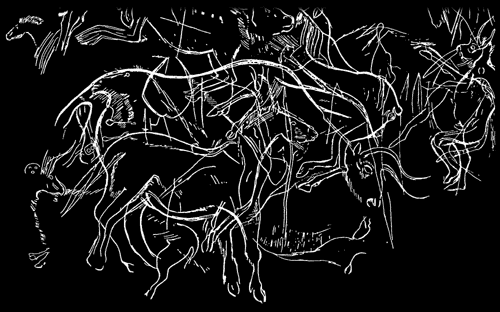
"Venus and the Sorcerer" from the Cave at Chauvet
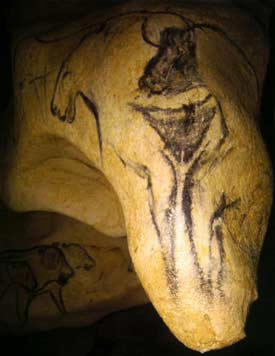
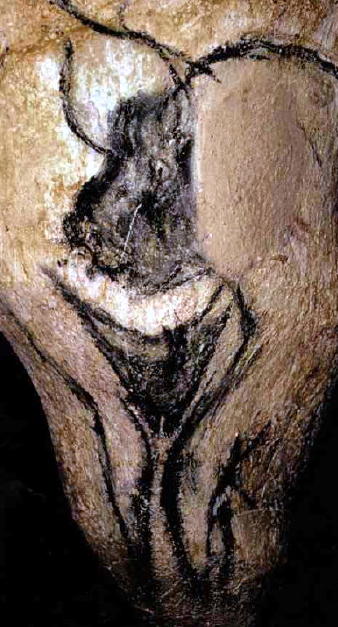
"The last and deepest of the Chauvet Cave chambers, the Salle du Fond, is the
home of the Venus and the Sorcerer. From the ceiling of the chamber, which is
nearly 7 m [20 feet] high, a vertical cone of limestone hangs down ending in a
point 1.10 m [3ft 6 ins] off the floor. It is on this hanging outcrop that the
Venus and the Sorcerer are drawn in black charcoal. The black pubic triangle of
the Venus is at eye level and seems to be the heart of the composition. It is
shaded in with black pigment. The white vulva slit appears to have been done
later with a pointed tool and is clearly indicated by a vertical line incised
strongly enough to cut through both the black pigment and the yellow surface
film of the rock. The legs, with plump thighs, finish in a point with the feet
not shown.
"This Venus is absolutely classical and her proportions, the stylistic elements,
the selection of the anatomical elements shown are all characteristically
Aurignacian or Gravettian, as known from the small Venus statues of Central and
Eastern Europe." - Jean Clottes, Return to Chauvet Cave
Related Readings
The Sorcerer of Les Trois Frere